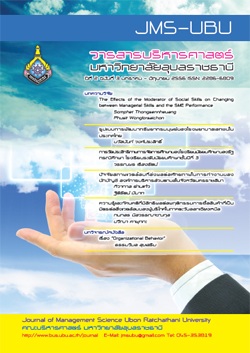การวัดประสิทธิภาพการจัดการศึกษาของโรงเรียนมัธยมศึกษาของรัฐ กรณีศึกษา โรงเรียนระดับมัธยมศึกษาชั้นปี ที่ 3
Main Article Content
บทคัดย่อ
การศึกษาในครั้งนี้มีวัตถุประสงค์เพื่อวัดประสิทธิภาพการจัดการศึกษาและวิเคราะห์ถึงปัจจัยที่มีอิทธิพลต่อประสิทธิภาพในการจัดการศึกษาของโรงเรียนระดับมัธยมศึกษาของรัฐด้วยวิธีการวิเคราะห์ด้วยแบบจำลอง DEA (Data Envelopment Analysis) เนื่องจากเป็นระดับการศึกษาภาคบังคับที่กฎหมายกำหนดและเป็นระดับการศึกษาที่มีสัดส่วนการใช้งบประมาณที่สูง และวิเคราะห์ปัจจัยที่คาดว่าจะมีอิทธิพลต่อประสิทธิภาพในการจัดการศึกษาของโรงเรียนด้วยวิธีกำลังสองน้อยที่สุด ข้อมูลที่ใช้ในการศึกษา คือโรงเรียนระดับมัธยมศึกษาปีที่ 3 ในปีการศึกษา 2552 ที่อยู่ในสังกัดสำนักงานคณะกรรมการการศึกษาขั้นพื้นฐาน (สพฐ.) กระทรวงศึกษาธิการ ทั่วประเทศ (ไม่รวมโรงเรียนสาธิตและเอกชน) จำนวน 2,361 โรงเรียน โดยแบ่งออกเป็น 2 กลุ่ม คือ กลุ่มโรงเรียนทั่วไป 1 จำนวน 1,254 โรงเรียน และกลุ่มโรงเรียนในฝัน 2 จำนวน 1,107 โรงเรียน
ผลการศึกษา พบว่า การจัดการศึกษาของโรงเรียนมัธยมศึกษาของรัฐโดยรวมยังไม่มีประสิทธิภาพ โดยเฉพาะประสิทธิภาพด้านปัจจัยการผลิต ซึ่งความไม่มีประสิทธิภาพมาจากการใช้ปัจจัยการผลิตในปริมาณมากในขณะที่ได้ผลผลิตตํ่า สำหรับผลการวิเคราะห์ปัจจัยที่มีอิทธิพลต่อประสิทธิภาพในการจัดการศึกษาของโรงเรียน พบว่า ปัจจัยที่มีความสัมพันธ์ในเชิงบวกกับประสิทธิภาพในการจัดการศึกษาของโรงเรียน ได้แก่ เปอร์เซ็นต์ของครูที่จบในระดับปริญญาตรี หรือสูงกว่าความพร้อมของสื่อการเรียนการสอน จำนวนนักเรียนในโรงเรียน และรายได้เฉลี่ยต่อหัวต่อปีของคนในตำบลที่เป็นที่ตั้งของโรงเรียน ทั้งนี้ปัจจัยที่มีอิทธิพลต่อประสิทธิภาพในการจัดการศึกษาของโรงเรียนมากที่สุด คือ เปอร์เซ็นต์ของครูที่จบในระดับปริญญาตรีหรือสูงกว่า รองลงมาคือ ความพร้อมของสื่อการเรียนการสอน
The Efficiency Measurement of Educational Management of the Public Secondary Schools: Case Study the Third Year Students
The purposes of this study were to measure the efficiency of educational management and to analyze the influential factors of the efficiency of educational management of the public secondary schools by Data Envelopment Analysis (DEA), because it was a compulsory education and spent more budgets, including to analyze the expected factors that affected the efficiency of educational management of the public secondary schools by least square method. The data used in this study was the third year students in the secondary school in the year 2009 under the Basic Education Commission (OBEC), Ministry of Education. 2,361 schools across the country (not including the demonstrate schools and the private schools) was divided into two groups of schools such as 1,254 general schools and 1,107 labschools. The results of measure the efficiency of educational management of the public secondary school concluded that the secondary schools generally were inefficiency, especially in input. The inefficient schools had using more inputs but lower outputs.
The results of the expected factors analysis affected the efficiency of educational management of the public secondary schools. These concluded that factors positively affected educational management efficiency of schools such as percentage of teachers who graduated bachelor degree or above, complete educational instruments, number of students, and average incomes per person per year of people in community. In order that, the most factors which affected educational management efficiency of schools such as the percentage of teachers who graduated bachelor degree or above and the complete educational instruments respectively.
Downloads
Article Details
บทความที่ตีพิมพ์ในวารสารบริหารศาสตร์ มหาวิทยาลัยอุบลราชธานี เป็นลิขสิทธิ์ของวารสาร โดยเนื้อหาและความคิดเห็นในบทความเป็นความรับผิดชอบของผู้เขียนแต่ละท่าน ไม่เกี่ยวข้องกับคณะบริหารศาสตร์ มหาวิทยาลัยอุบลราชธานีแต่อย่างใด และหากมีข้อผิดพลาดประการใด ผู้เขียนจะเป็นผู้รับผิดชอบต่อบทความของตนเองแต่เพียงผู้เดียว

